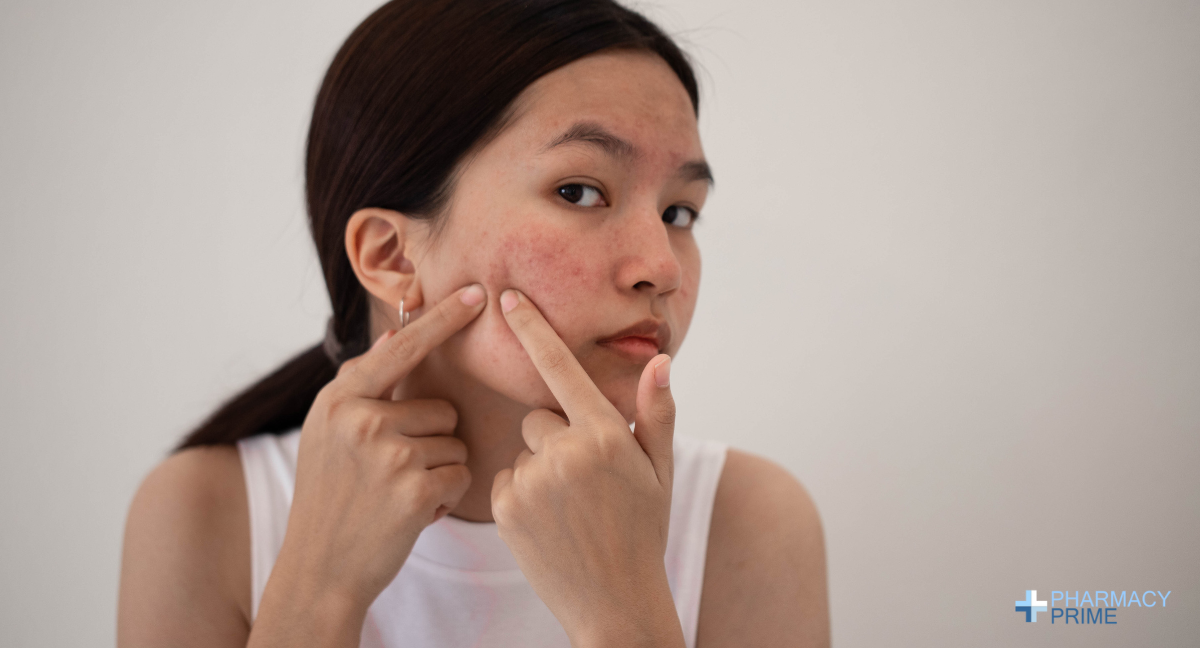Introduction
In this blog, we will look at what acne is and its causes, what it looks like, and how you can try to treat it. Almost everyone will suffer from acne at some point, so you are not alone!
What is acne?
Acne is a common skin condition that affects most people at some point in their life, to varying degrees. It causes oily skin and spots, and sometimes your skin can feel hot or painful to touch.
What causes acne?
Acne is most commonly linked to hormonal changes during puberty, but it can start at and affect people of any age. Although about 95% of young people aged between 11 and 30 are affected by acne to some extent, about 3% of adults over the age of 35 still have acne.
There are hormones that can cause your glands to produce larger than usual amounts of oil, which can in turn cause a normally harmless skin bacterium (P. acnes) to become more aggressive, resulting in inflammation and pus. These hormones can also thicken the inner lining of hair follicles, which causes pore blockage.
Similarly, hormonal changes during women’s menstrual cycles or pregnancy can contribute to acne episodes.
Acne is also known to run in families, so if your parents had acne, you are more likely to suffer from it as well.
Most people find that their acne resolves by the time they are in their mid-20s.
What does acne look like?
Acne most commonly develops in the following areas:
- Face - almost everyone with acne.
- Back - more than half of people with acne.
- Chest - about 15% of people with acne.
Acne can cause 6 main types of spots. Often, if you suffer from acne, you will have a combination of the following:
- Blackheads - small black or yellowish bumps that develop on the skin.
- Whiteheads - similar in appearance to blackheads, but may be firmer and will not empty when squeezed.
- Papules - small, red bumps on the skin that may feel sore or tender.
- Pustules - similar to papules but with a white tip in the centre, and which are caused by a buildup of pus.
- Nodules - large, hard lumps that build up beneath the surface of the skin, and which can be painful.
- Cysts - the most severe spots caused by acne, which are pus-filled lumps (similar in appearance to boils) and which carry a risk of causing permanent scarring.
How do I treat acne?
There are many different things you can do to help with acne. Although it cannot be cured, it can be controlled with treatment, including different lifestyle habits and products, including prescription items.
Try not to wash the affected areas of skin more than twice a day, as frequent washing can irritate the skin and make symptoms worse. You should use lukewarm water, as too hot or too cold water can make acne worse.
Avoid makeup and skincare products that are oil-based, and instead use water-based products, as these are less likely to clog your pores. CeraVe Hydrating Cleanser, Nip+Fab Charcoal Fix & Mandelic Acid Cleansing Wash, and Cetaphil Gentle Skin Cleanser are some examples. Always be sure to completely remove makeup before going to bed.
There are specialty acne products which you can use after carefully washing and drying the affected areas. Products containing benzoyl peroxide, such as Acnecide, can be helpful, but be careful to avoid contact with clothing when using these, as they can have a bleaching effect.
Avoid trying to squeeze spots or “clean out” blackheads, as this can make them worse and potentially cause scarring.
If you suffer from dry skin in addition to acne, we recommend a water-based, fragrance-free emollient, such as Aveeno Dermexa Daily Emollient Body Wash, Cetraben Emollient Cream, or Zerobase Emollient Cream.
Shower as soon as you can after exercise, as sweat can make acne worse. You should also regularly wash your hair and try to keep it from falling across your face.
It’s always a good idea to speak to your pharmacist or GP if you are unsure what to do, need advice, or begin to develop more severe acne, especially on your chest or back, or you have cysts or nodules. You may need to try some antibiotics or a prescription treatment.
Many acne treatments take several months to work, so it is important to remember to be patient and to be consistent.
In summary
Acne is a common skin condition that affects most people at some point in their life, although it’s most common between the ages of 11 and 30, with many people seeing their skin clear up once they reach their mid-20s. Although acne can’t be cured, it can be treated and its symptoms eased, typically through small lifestyle changes such as twice daily face washing and the thorough removal of makeup, as well as selecting appropriate skincare products. In some instances, you should seek advice from your GP or pharmacist if the acne is more severe, on your back or chest, or you develop nodules and cysts.

